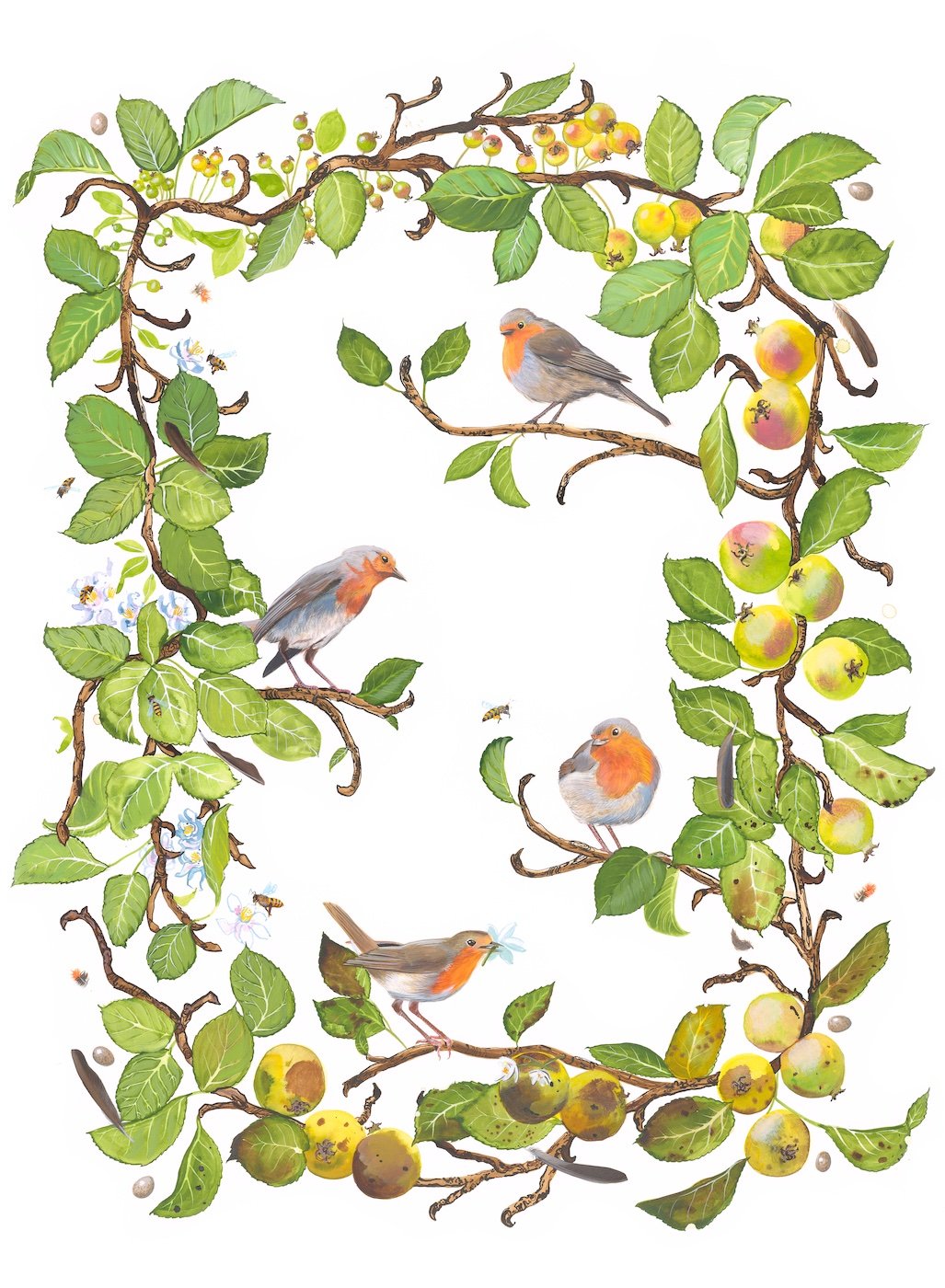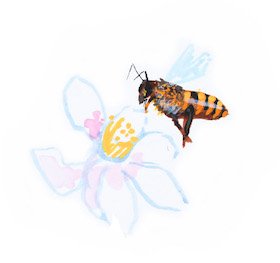European Robin (Erithacus rubecula)
Painting by Missy Dunaway. Created with acrylic ink on paper. 30x22 inches (76x56 cm)
Painting Key
Fauna: 4 European robins (Erithacus rubecula), 6 honeybees
Objects: 6 European robin eggs, 10 European robin feathers
Plants mentioned by Shakespeare: European crab apple (Malus sylvestris)
Shakespeare’s Robin
Occurrences in text: 3
Plays: Cymbeline, Henry IV Part 1, The Two Gentlemen of Verona
Name as it appears in the text: “robin-redbreast,” “ruddock,” “redbreast”
The first day of spring is March 20th so The Birds of Shakespeare is moving along to a favorite springtime bird. The robin is one of the most familiar birds in the British landscape, so I expected to find it hopping in the setting of every play. To my surprise, there are only three explicit references to the bird, otherwise called a “robin-redbreast,” “red-breast,” or “ruddock.”
The 19th-century ornithologist James Edmund Harting describes the robin as a “songster of less note mentioned by Shakespeare.”[1] According to Harting, early modern naturalists and Elizabethans believed that the robin and wren were male and female of a single species.[2] The wren would add to the robin’s numbers, as it is mentioned nine times. However, I have chosen to represent the wren and robin individually in my project, as they are different species and appear independently in Shakespeare’s works.
The robin’s cheerful, twittering voice is heard around human habitats day and night. Its sentimental song is mentioned in The Two Gentlemen of Verona when Speed mocks Valentine. Speed says he can tell that Valentine is in love because he sings love songs like a robin:
Two Gentlemen of Verona (Act II, Scene 2, Line 17)
VALENTINE: Why, how know you that I am in love?
SPEED: Marry, by these special marks: first, you have
learned, like Sir Proteus, to wreathe your arms like
a malcontent; to relish a love song like a robin
redbreast; to walk alone like one that had the
pestilence; to sigh like a schoolboy that had lost his
ABC; to weep like a young wench that had buried
her grandam; to fast like one that takes diet; to
watch like one that fears robbing; to speak puling
like a beggar at Hallowmas.
The robin also appears in Henry IV, Part 1. Henry Percy tries to convince Lady Percy to slip away from their group to make love before he leaves for war. Hotspur teases his wife by saying she’s acting like an innocent maid when he knows she is a sophisticated, experienced woman. He suggests that if she wants to act like a naïve country woman, she should take up a provincial vocation, such as a tailor or a “red-breast teacher,” meaning a music teacher:[3]
Henry IV, Part 1 (Act III, Scene 1, Line 254)
HOTSPUR: Come, Kate, I’ll have your song too.
LADY PERCY: Not mine, in good sooth.
HOTSPUR: Not yours, in good sooth! Heart, you swear
like a comfit-maker’s wife! “Not you, in good
sooth,” and “as true as I live,” and “as God shall
mend me,” and “as sure as day”—
And givest such sarcenet surety for thy oaths
As if thou never walk’st further than Finsbury.
Swear me, Kate, like a lady as thou art,
A good mouth-filling oath, and leave “in sooth,”
And such protest of pepper-gingerbread
To velvet-guards and Sunday citizens.
Come, sing.LADY PERCY: I will not sing.
HOTSPUR: ’Tis the next way to turn tailor, or be redbreast
teacher. An the indentures be drawn, I’ll
270 away within these two hours, and so come in when
you will. He exits.
Hotspur teases his wife, Lady Percy, and calls her a “redbreast teacher” before departing for war. Painting by Alexandre Bida (1813-1895). Folger Shakespeare Library
My favorite reference to the robin takes an unexpected turn towards the macabre. According to Renaissance folklore, robins were kind and adored humans so deeply that if one came upon a person who had passed away, it would place flowers on the body.[4]
Shakespeare’s contemporary, Michael Drayton, describes the practice in his poem, The Owl (1604):
“Covering with moss the dead unclosed eye, the little redbreast teacheth charity.”[5]
In Shakespeare’s Cymbeline, Arviragus adorns the body of Fidele (actually Imogen) with flowers, as “the ruddock would, with charitable bill.” Unbeknownst to Arviragus, Fidele is not deceased but unconscious after taking a potion. Now, when I see our familiar American robin hopping around a cemetery, I remember this poignant scene from Cymbeline:
Cymbeline (Act IV, Scene 2, Line 280)
ARVIRAGUS, ⌜as Cadwal⌝ With fairest flowers,
Whilst summer lasts and I live here, Fidele,
I’ll sweeten thy sad grave. Thou shalt not lack
The flower that’s like thy face, pale primrose; nor
The azured harebell, like thy veins; no, nor
The leaf of eglantine whom, not to slander,
Out-sweetened not thy breath. The ruddock would
With charitable bill—O bill, sore shaming
Those rich-left heirs that let their fathers lie
Without a monument—bring thee all this,
Yea, and furred moss besides, when flowers are none
To winter-ground thy corse.
In my painting, robins flit between the boughs of a European crab apple tree (Malus sylvestris). The tree moves from springtime flowers to late autumn apples as it travels clockwise around the page. A robin places flowers on a rotten crab apple at the bottom of the composition.
Finally, I do not want to overlook 26 other appearances of the word “robin,” which refer to someone’s name: Robin Hood, Robin Goodfellow (also known as Puck in A Midsummer Night’s Dream), and Falstaff’s page, Robin, in The Merry Wives of Windsor. All these characters share qualities with robins: Robin Hood is charitable, Robin Goodfellow is a forest creature, and Falstaff’s page is described as “little Robin,” suggesting he is diminutive.
The robin may not receive much attention from Shakespeare, but it is depicted truthfully as sweet, musical, and understated.
Endnotes
[1] Harting, J., The Birds of Shakespeare, (London: John Van Voorst, Paternoster Row, 1871), 139.
[2] Harting, J., The Birds of Shakespeare, (London: John Van Voorst, Paternoster Row, 1871), 139.
[3] Zeigler, Ehren, host. “Don’t Poke The Dragon.” Chop Bard, episode 94, In Your Ear Shakespeare, 2012, https://chopbard.libsyn.com/94-dont-poke-the-dragon.
[4] Harting, J., The Birds of Shakespeare, (London: John Van Voorst, Paternoster Row, 1871), 139.
[5] Phipson, Emma. Animal Lore of Shakespeare's Time. Glastonbury, The Lost Library, Kegan Paul, 1883. p. 179.



